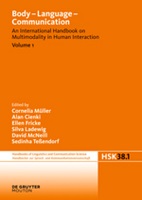Chapter 44 A “Composite Utterances” approach to meaning 45. Towards a grammar of gestures
A form-based view
| dc.contributor.author | Enfield, N. J. | |
| dc.contributor.editor | Müller, Cornelia | |
| dc.contributor.editor | Fricke, Ellen | |
| dc.contributor.editor | Cienki, Alan | |
| dc.contributor.editor | McNeill, David | |
| dc.contributor.editor | Ladewig, Silva | |
| dc.contributor.editor | Tessendorf, Sedinha | |
| dc.date.accessioned | 2020-01-07 16:47:06 | |
| dc.date.accessioned | 2020-04-01T09:28:29Z | |
| dc.date.accessioned | 2019-11-15 23:55 | |
| dc.date.accessioned | 2020-01-07 16:47:06 | |
| dc.date.accessioned | 2020-04-01T09:28:29Z | |
| dc.date.available | 2020-04-01T09:28:29Z | |
| dc.date.issued | 2013 | |
| dc.identifier | 1006376 | |
| dc.identifier | OCN: 1135847417 | en_US |
| dc.identifier.uri | http://library.oapen.org/handle/20.500.12657/23766 | |
| dc.description.abstract | This chapter argues for a composite utterances approach to research on body, language, and communication. It argues that to understand meaning we need to begin with the utterance or speech act as the unit of analysis. From this perspective, the primary task in interpreting others’ behaviour in communication is to infer what a person wants to say. In order to solve this task, an interpreter is free to consult any and all available information, regardless of the sensory modality in which that information is gathered (e.g., vision versus hearing), and regardless of the semiotic function of that information (e.g., iconic/indexical, symbolic/conventional, or some combination of these). Having recognized that another person has an intention to communicate, an interpreter takes the available relevant information (e.g., vocalizations, facial expressions, hand movements, all in the context of synchronic knowledge of linguistic and cultural systems, and other aspects of common ground) and looks for a way in which those cooccuring signs may simultaneously point to a single overall message of the move that a person is making. This is helped by the binding power of social cognition in an enchronic context (that is, the sequential context of turn-by-turn conversation), in particular the assumption that people are not merely saying things but making moves. The chapter focuses on co-speech hand gestures, and also discusses implications of the composite utterances approach to research on syntax, and on sign language. | |
| dc.language | English | |
| dc.subject.classification | thema EDItEUR::C Language and Linguistics::CF Linguistics | en_US |
| dc.subject.classification | thema EDItEUR::G Reference, Information and Interdisciplinary subjects::GT Interdisciplinary studies::GTC Communication studies | en_US |
| dc.subject.other | Multimodal Communication | |
| dc.subject.other | Embodiment | |
| dc.title | Chapter 44 A “Composite Utterances” approach to meaning 45. Towards a grammar of gestures | |
| dc.title.alternative | A form-based view | |
| dc.type | chapter | |
| oapen.identifier.doi | 10.1515/9783110261318.689 | |
| oapen.relation.isPublishedBy | 2b386f62-fc18-4108-bcf1-ade3ed4cf2f3 | |
| oapen.relation.isPartOfBook | e190effb-a9c0-4189-959e-5f8fea9521dd | |
| oapen.relation.isFundedBy | 7292b17b-f01a-4016-94d3-d7fb5ef9fb79 | |
| oapen.relation.isbn | 9783110209624 | |
| oapen.collection | European Research Council (ERC) | * |
| oapen.collection | EU collection | * |
| oapen.place.publication | Berlin/Boston | |
| oapen.grant.number | 240853 | |
| oapen.grant.acronym | HSSLU | |
| oapen.identifier.ocn | 1135847417 |

